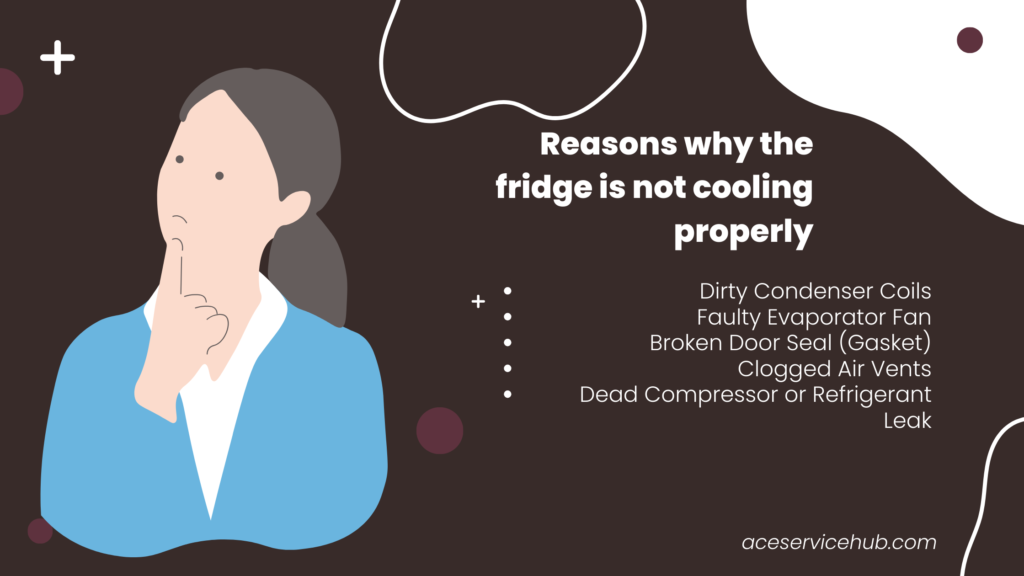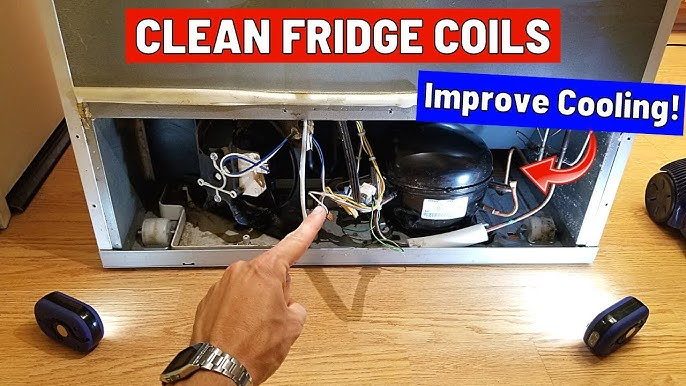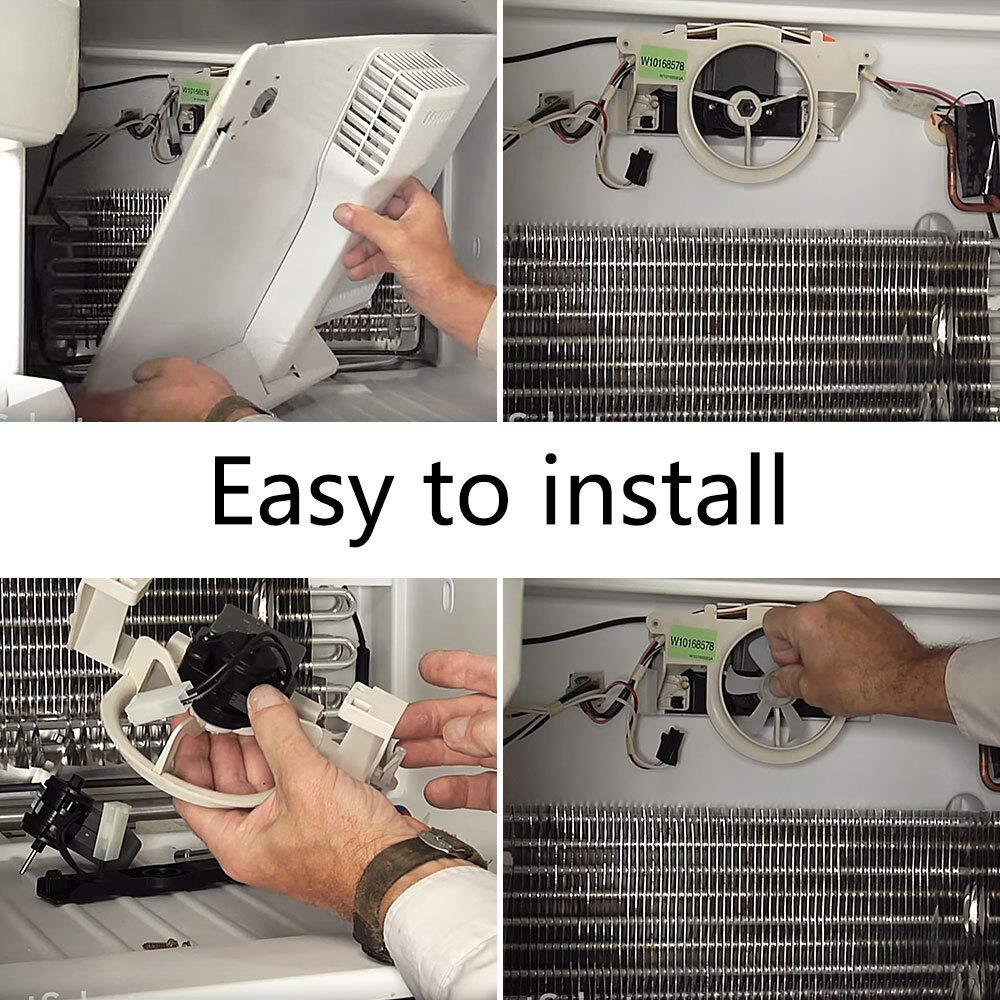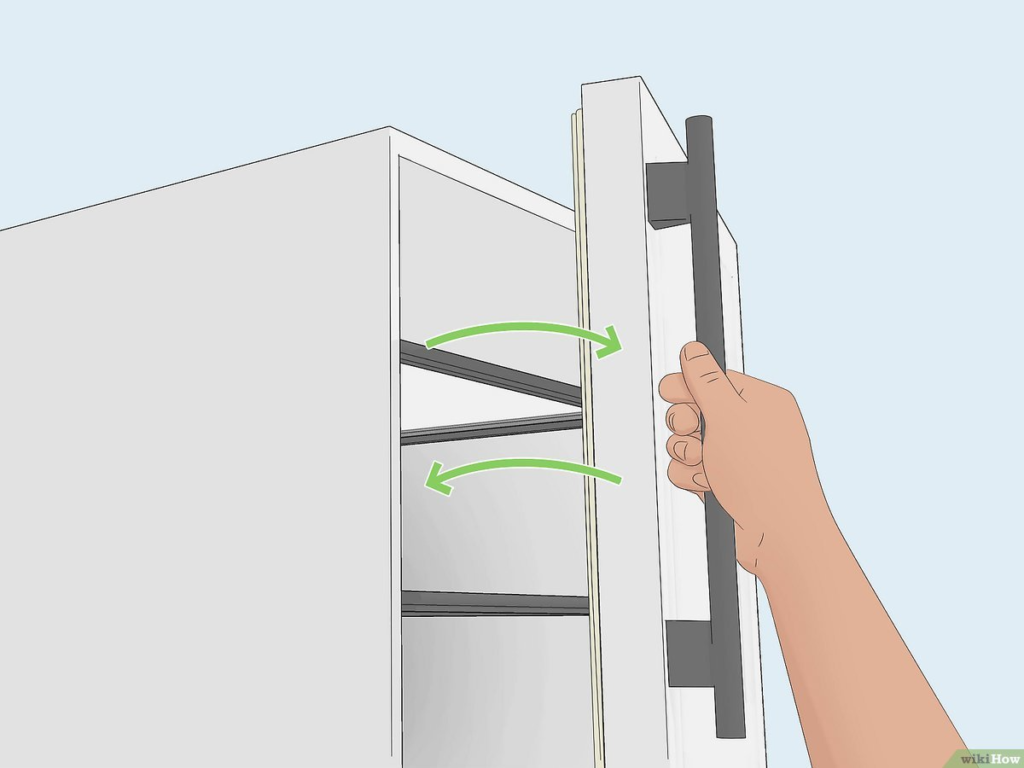If your refrigerator is not cooling, first check that the power supply of the refrigerator is fine, then check the condenser coil of the refrigerator, then check the compressor of the refrigerator that it is working properly. Also check the elevator fan of the refrigerator that it is working properly. Check the door of the refrigerator to see if it is closing completely or not. Check the rubber seal to see if it is loose or torn because air leakage affects cooling.
- Ensure the power cord is plugged in and the outlet works.
- Confirm the thermostat isn’t accidentally turned down.
- Check if the door closes fully and the seal isn’t torn.

fridge not cooling
How a Refrigerator Cooling System Works:
Understanding how your fridge cools can make refrigerator troubleshooting much easier. Inside, a compressor pumps refrigerant through coils, first turning it into a hot gas, then a cool liquid. The evaporator coils absorb heat from inside, while the condenser coils release heat outside. A thermostat or temperature sensor tells the compressor when to start and stop. When any part—compressor, coils, or thermostat—malfunctions, you get cooling issues.
Compressor: Pumps refrigerant (coolant) through coils.
Condenser Coils (outside): Release heat from the fridge.
Evaporator Coils (inside): Absorb heat to cool the interior.
When any part fails, cooling stops. Let’s find out why yours isn’t working.
Top Reasons Your Fridge Isn’t Cooling?
- Dirty Condenser Coils
- Faulty Evaporator Fan
- Broken Door Seal (Gasket)
- Clogged Air Vents
- Dead Compressor or Refrigerant Leak
Each of these problems affects your fridge’s ability to maintain a cold temperature and can be addressed with proper knowledge and care. -
Dirty condenser coils:
Symptoms: Fridge feels warm, humming compressor sounds strained.
Dirty condenser coils are a common cause of a fridge not cooling properly. These coils, usually located at the back or underneath the refrigerator, release heat from inside. When dust, pet hair, and dirt cover them, the fridge has to work harder to stay cool. This reduces efficiency and increases energy use.
To clean your condenser coils safely and effectively: - Unplug the fridge to avoid electrical hazards.
- Locate the coils at the back or under the fridge.
- Use a soft brush or vacuum with a brush attachment to remove dust and debris gently.
- Avoid bending or damaging the coils while cleaning.
- Clean the coils every six months to keep your fridge running efficiently and prevent costly repairs.
- Regular coil cleaning helps maintain proper cooling and saves energy in the long run.
Pro Tip: Clean coils every 6 months to save energy and avoid breakdowns.
Faulty Evaporator Fan:
Symptoms: Freezer works, but fridge is warm; no humming noise.
If your fridge isn’t cooling properly, the evaporator fan might be the issue. This small fan, located inside the freezer, helps circulate cold air throughout the fridge. When it stops working, the freezer may stay cold, but the fridge won’t. Open the freezer and listen—if you don’t hear the fan running, it could be stuck or broken. Sometimes ice buildup blocks it; unplug the fridge and let it defrost. If it still doesn’t work, the fan motor may need replacement. Checking this fan is easy and could save you from a costly repair!
If the fan doesn’t spin, replace it (under $50 for most models).
Broken Door Seal (Gasket):
Symptoms: Cold air escapes, condensation on shelves
A torn or loose door seal lets cold air escape, forcing your fridge to overwork. Here’s how to fix it for under $60:
- Test the Seal: Close the door on a dollar bill. If it slips out easily, the gasket is faulty.
- Clean the Gasket: Wipe with warm, soapy water to remove debris affecting the seal.
- Buy the Correct Replacement: Find your fridge’s model number (inside the fridge) and order a matching gasket online ($20–$60).
- Remove the Old Seal: Pry it off gently with a flathead screwdriver, starting at the corners.
- Install the New Gasket: Press it firmly into the groove, working clockwise. Close the door for 1–2 hours to set the seal.
Pro Tip: Use a hair dryer on low heat to soften stiff new gaskets for easier installation.
Clogged Air Vents:
Symptoms: Uneven cooling, frost in the freezer.
Blocked vents disrupt airflow, causing uneven cooling or frost buildup. Here’s how to clear them fast:
- Unplug the Fridge: Safety first.
- Locate Vents: Check the back wall (fridge) and near the freezer shelf.
- Remove Obstructions: Move food, containers, or ice blocking vents. Use a hair dryer (cool setting) to melt minor frost.
- Restore Airflow: Leave 2–3 inches between items and vents.
Pro Tip: Clean vents monthly with a vacuum brush to avoid dust buildup.
Dead Compressor or Refrigerant Leak:
A silent fridge or hissing near the coils often signals a dead compressor or refrigerant leak. Here’s what to do:
Symptoms:
- The fridge stays warm despite running.
- Oily stains under the fridge (leak clue).
- Loud clicks but no cooling (compressor failure).
Act Fast:
- Unplug the fridge to avoid compressor burnout.
- Never handle refrigerant—it’s toxic and illegal without EPA certification.
Call a Pro Immediately:- Licensed technicians use leak detectors and repair coils or replace compressors.
- Costs range from $300–$800, depending on the issue.
When to Call a Pro (Save Time & Money)
Don’t risk DIY repairs if you spot:
⚠️ Refrigerant leaks (requires EPA certification).
⚠️ Burnt wiring smells (fire hazard).
⚠️ Compressor failure (costs $300–$600; often not worth fixing for older models).
How to Choose a Reliable Technician- Check Credentials: Ask for EPA 608 certification (legally required for handling refrigerants).
- Read Reviews: Look for 4.5+ stars on Google/BBB and specific praise for fridge repairs.
- Compare Pricing: Get upfront quotes—most repairs cost $150–$400. Avoid vague “diagnostic fees.”
Cost Breakdown: Repair vs. Replace
| Issue | Repair Cost | Replace Fridge? |
| Compressor | $400–$800 | If fridge is 8+ years old |
| Control Board | $200–$400 | If newer model (under 5 years) |
| Refrigerant Leak | $250–$500+ | If leak is in hard-to-reach coils |
FAQ:
Q:How do we fix a refrigerator that is not cooling?
Ans: Start by cleaning the condenser coils and checking the evaporator fan. If these don’t work, test the thermostat and door gasket. For refrigerant leaks or compressor issues, professional repair is recommended.
Q: What is the first thing to check when a refrigerator stops cooling?
Ans: The first thing to check is the condenser coils for dirt and dust buildup, as dirty coils can cause poor cooling by making the compressor work harder.
Q: Why is my refrigerator compressor running but not cooling?
Ans: This usually happens when the evaporator fan is broken or blocked, preventing cold air from circulating inside the fridge despite the compressor running.
Q:Why is cooling less in the fridge?
Ans: Cooling may be less due to blocked vents, overloaded shelves, dirty coils, or a failing thermostat, all of which restrict proper cold air circulation.










